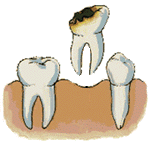| Tooth Loss | Missing Teeth |

Tooth Loss | Missing Teeth
Tooth loss is a term used when one or more teeth fall out or are extracted most usually due to dental diseases such as tooth decay and gum disease, or due to tooth injuries or mouth trauma. The medical term for the condition of missing teeth, as a result of tooth loss, is edentulism. Loss of only some teeth is termed as partial edentulism, while when all teeth are missing it is called complete edentulism.
Causes of tooth loss
The main possible causes of tooth loss include:
- Severe tooth decay: Dental cavities cause the destruction of the hard tissues of the tooth. If the tooth structure is damaged beyond repair or there is a tooth abscess that can not be controlled by root canal treatment, the tooth will be lost.
- Advanced periodontal disease: Gum disease is the leading cause for tooth loss in adults. Advanced periodontitis causes the destruction of the periodontal tissues that support teeth. Without the gums and jaw bone around them to keep them in place, the affected teeth become loose and fall out or have to be extracted.
- Physical trauma or tooth injury: Sports and accidents are responsible for many of the lost teeth that suffer an irreversible damage due to physical trauma.
Several factors have been found to increase the risk of tooth loss, such as some medical conditions, pregnancy, bruxism, lack of dental care, dental fear, poor finances and many other.
Is tooth loss inevitable? How to prevent tooth loss?
Being edentulous has been considered as a natural condition for the elderly until some decades ago. However, the progress of dental science and improved public awareness have shown that tooth loss is not an unavoidable effect of aging. The percentage of the population that is edentulous is steadily decreasing in all age groups, mainly due to better access to dental care and improved treatments for tooth decay and gum disease.
The following statistics about missing teeth and edentulism in United States, are based on National Health and Nutrition Examination Survey, 1999–2004
AGE | Num of missing teeth | Edentulism % |
20 to 34 years | 5.10 missing teeth | na |
35 to 49 years | 6.95 missing teeth | 2.63% |
50 to 64 years | 9.70 missing teeth | 10.13% |
65 to 74 years | 12.66 missing teeth | 23.93% |
75+ years | 13.64 missing teeth | 31.30% |
Although we typically associate tooth loss with older age, over 25% of the population has lost at least one tooth until the age of 30. Regular visits to the dentist for cleanings twice a year and good oral hygiene are the most important factors that can help you retain your teeth for all your life.
Effects of tooth loss – Why replace missing teeth?
Having lost several or all permanent teeth can have significant consequences on the patient’s overall health, both physical and psychological. Physical effects of tooth loss include the weakening of any remaining teeth, jaw bone loss, facial collapse, TMJ disorders, chewing and nutrition problems. Social and psychological effects of tooth loss are also important. Tooth loss can cause social embarrassment, anxiety and speech problems, decrease self-esteem and increase emotional stress.
Missing teeth negatively affect the patient’s general health and quality of life. Dentists recommend that all missing teeth have to be replaced to prevent more dental and health problems in the future.
Tooth loss is basically a problem when it refers to permanent teeth, as primary teeth (baby teeth) are supposed to fall out any way and give their place to the permanent teeth. However in some cases the loss of a primary tooth can also cause problems, especially if it is lost too early.
Tooth replacement options - How to replace missing teeth?
There are three possible tooth replacement options if you have lost one or more teeth: dental bridges, dentures (full or partial) and dental implants.
- The best way to replace missing teeth are dental implants. They offer the best aesthetic and functional result resembling more to the natural teeth. However they still remain the most expensive solution, especially if there are many missing teeth.
- A dental bridge is the most common way used to replace a single missing tooth. It consists of a false replacement tooth (pontic) fixed on two crowns, one on each side to support it. The main disadvantage of dental bridges is that the adjacent healthy teeth have to be trimmed before the crowns are fitted.
- Dentures provide the most common and economic tooth replacement option when many or all teeth have been lost, but they are uncomfortable and look much less natural than bridges and implants.
Which tooth replacement option will be used depends on the number of missing teeth to replace, the condition of any remaining teeth, the aesthetic requirements of the patient and the cost of the treatment.
- Dental Plaque
- Dental Calculus
- Gum Disease
- Tooth Decay
- Tooth Abscess
- Toothache
- Tooth Loss
Related Problems
- Root Canal Therapy
- Dental Restoration
- Dental Fillings
- Inlays -Onlays
- Dental Crowns
- Dental Bridges
- Dentures
- Dental Implants
articles about
Tooth Restoration
